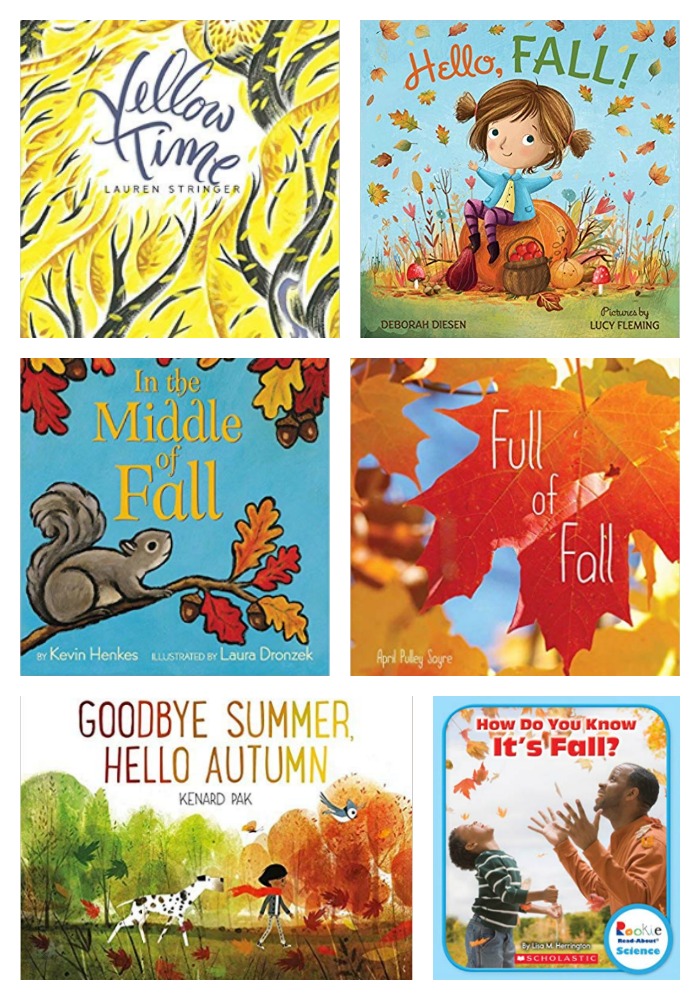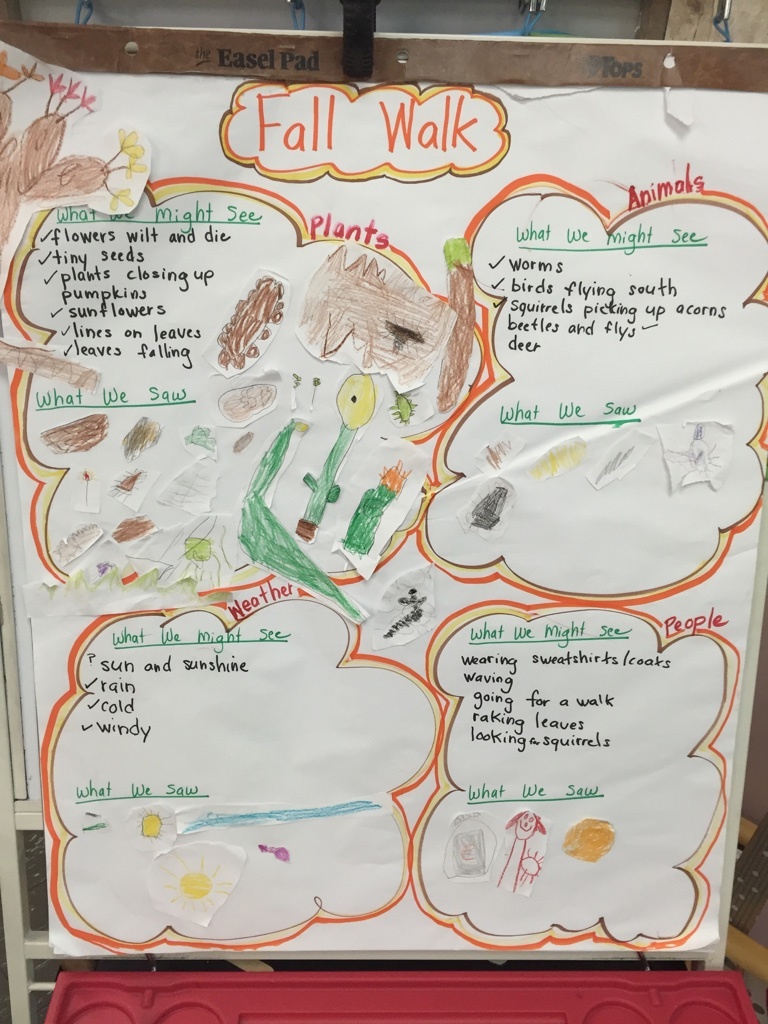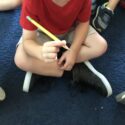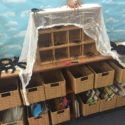Inside: In this post, I share the fall inquiries my children explored as part of a year-long inquiry that investigated the changes that occur in plants, animals, weather, and people, across the seasons.
Beginning in Inquiry
I became interested in inquiry-based learning after seeing videos of kindergarten teachers from Canada teaching in a way that was much more student-centered than the way I currently taught. So, after reading a few books over the summer, I decided to explore this way of teaching when the next school year rolled around.
Initially, I was a little uncomfortable with the “looseness,” of it all. So, I planned a year-long inquiry that provided some structure to the way I would frame our science curriculum, but still left room for children’s questions.
This inquiry was built around the broad topic of “change,” and was designed for kids to explore the changes that occurred in animals, plants, weather, and people across the seasons.

The big goal for this year-long inquiry was to help children see the patterns, cycles and interdependence of the natural world.
Our Fall Inquiries
What follows are the steps we took that fall, as we built background, formed research groups, asked questions, researched answers, and shared our learning with others.
Step 1: Building Background
Cycle of the Seasons: Before we jumped into exploring the season of fall, I wanted to spend some time helping children understand the cycle of all four seasons. This four seasons mat was used to help children visualize and understand the Earth’s movement around the sun.

The mat was also used for each child’s birthday circle, so the concept was revisited each time we celebrated a birthday.
Next, we did some whole group, schema-building experiences to support us in asking the questions that would eventually frame our fall inquiries.
Fall Books: We read books such as Yellow Time, Hello, Fall!, In the Middle of Fall, Full of Fall, Goodbye Summer, Hello Autumn, and How Do You Know it’s Fall? to help us identify signs of the season.

Fall Walk: We then took a Fall Walk to look outdoors for those seasonal “signs” within these four areas: plants, animals, weather, and people.

We used this anchor chart to record what we might see before the walk, and then what we actually saw once the walk was over.

Fall Treasures: I designated an area within our Science Center, for objects and resources related to the current season. Both the children and I brought in objects such as sunflowers, acorns, leaves, apples, corn, pumpkins, gourds, and more that they could explore both on our Cool Collections Tray and in the Take-Apart Tub.



Children were able to use these materials while working at Choice Time Centers during Discovery Workshop.
Step 2: Establishing Research Groups
Once the children had some prior knowledge about the season, they chose a research group by placing their picture under the category they were most interested in studying (plants, animals, weather, or people).

Since we would repeat the process each season (fall, winter, spring), this meant that they would get a chance to work in 3 different research groups before the school year ended.
Step 3: Recording Children’s Fall Inquiry Questions
When I met with each research group for the first time, I read a book about their specific topic (i.e. Animals in Fall) and asked each child to share one question.
I wrote their “wonders” on our inquiry board.

I noticed some interesting things about their questions:
- Most were high level (how and why).
- Many I could not answer and became curious about as well!
- It was a lot to ask a 4-5 year old to come up with a question about a season AND a specific topic (i.e. fall weather) when many don’t even know what a question is.
- All but one child was able to come up with a question.
- Reading the book, prior to eliciting questions, was a crucial scaffold and an essential step.
- The children took ownership of their questions.
The children’s questions were then used to drive our fall inquiries from that point forward.
Step 4: Planning Next Steps for Our Fall Inquiries
I ordered the children’s questions to match the timing of seasonal changes in our area and brainstormed experiences and resources that could be used to help children with their research.
I met with our librarian and shared our questions with him in hopes that he might want to collaborate or offer resources.
Then, I scheduled time to meet with each research group during Discovery Workshop, while the rest of the kids worked at Choice Time Centers. Each meeting focused on one of their questions.
Step 5: Meeting with Research Groups
Working with these small groups to answer their questions, was the most challenging part of the whole process, but it was also where I learned the most about teaching using an inquiry-based approach. Eventually, each meeting began to take shape and look a little something like this.

- Posing the Question: The child whose question it was would share their question and tell why they were curious to know the answer. Depending upon the type of question, I would clarify what we were looking for. For example, if it was a “how” question, I would let them know that the answer would be a process or set of steps. If it was a “why” question, our answer might begin with “because” and would include a reason.
- Accessing Prior Knowledge: Each child in the group would share their own ideas about the answer to the question either verbally or through drawing. As I listened, I noted three things: what they already knew, what vocabulary they were using, and what misconceptions they had.
- Research: Prior to each meeting, I gathered resources that might help answer the question. With this step, I guided children in using these resources based on what I had learned in step 2. Sometimes this meant children were gleaning information from the illustrations in nonfiction books. Other times I read selected parts aloud to them. And once in awhile, they watched videos on iPads.
- Experiences: Whenever possible, I planned an experience for the kids that would help further their understanding. These experiences included experiments, STEM challenges, art experiences, or free explorations of objects. For example, their question, “How do squirrels find nuts?” led to an experiment where we wanted to see if squirrels would find acorns placed both in open and closed containers, teaching us something about how they used their senses to find food. And with the question, “How do people rake leaves?” children were challenged to design and build a rake to learn a little about the leaf raking process.

Step 6: Sharing Our Fall Inquiries with Others
During Discovery Workshop share time, whichever group I had met with, shared what they had learned about the question we researched that day. Sometimes they had a picture or page from a book to share, or I encouraged them to act out what they had learned, but most times this was just done verbally.
With the question, “How is popcorn made?,” children acted out the process for the class by showing how the kernels get heated and then they “POP!”
At the end of the season, I met with each group one final time and asked each child to name a way that plants, animals, weather, or people change in the fall.
They drew a picture to illustrate this and created a poster. We then shared our learning with another kindergarten class.

Reflections on Our Fall Inquiries
While the children learned a LOT of content throughout our studies, my focus was more on teaching the children how to ask questions, find information, and share their learning with others. Guiding each research group to answer their own questions was definitely the most challenging part for me. I often found it difficult to straddle that fine line between disseminating information and guiding the children to find their own answers.
Late in the season, we went for a pine cone walk. During the walk, they began to ask a lot of unsolicited questions such as, “Do pine cones have needles?” and I took this as evidence that we had made steps toward becoming more curious learners.

I attribute this, not to any one fall inquiry, but to the fact that children now knew that our classroom was a place where their questions and ideas were both valued and heard.
For more ideas on science and inquiry, check out the Growing with STEAM page inside the Roots & Wings Resource Library.
This post contains affiliate links. Roots & Wings is a participant in the Amazon Services LLC Associates Program, an affiliate advertising program designed to provide a means for sites to earn advertising fees by advertising and linking to Amazon.com.


 Launching Choice Time Centers at the Beginning of the Year
Launching Choice Time Centers at the Beginning of the Year 6 Building Blocks to Launch Your First Weeks of Kindergarten
6 Building Blocks to Launch Your First Weeks of Kindergarten Making a Plan for the Covid Friendly Classroom
Making a Plan for the Covid Friendly Classroom Center Transformations for Your Classroom Halloween Party
Center Transformations for Your Classroom Halloween Party